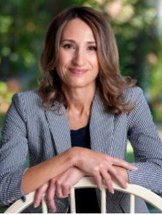[ad_1]
By Anne Levin

Becky Libourel Diamond
Becky Libourel Diamond was already at work on The Gilded Age Cookbook when the HBO series The Gilded Age debuted in January 2022. With season two of the show set to air October 29, the release of Diamond’s book, about which she will speak Thursday, September 7 at 7 p.m. in Princeton Public Library’s Community Room, couldn’t be timelier.
“I’m so excited they renewed the show. It’s a coincidence, but the timing turns out to be perfect,” said Diamond, who is the author of two other books related to two of her passions: food and history. “I’ve always been into food. And there is so much we can learn about history from food,” she said. “What did people eat back then, and why?”
Diamond’s mother, grandmother, and all of her aunts went to school for home economics, so her interest in food-related subjects isn’t surprising. A native of Burlington County, she majored in journalism at Rider University and earned a master’s degree in library science from Rutgers.
Diamond’s husband’s job took her family to England for two years, where they lived just outside London, within walking distance of Hampton Court Palace. They moved back to the U.S. in 2008, settling in Yardley, Pa., and Diamond began looking for work in publishing.
“I found there was a guy here, Bruce Franklin, with a small publishing company [Westholme], and I approached him about doing some editing work,” she said. “He said no. But I pitched him an idea for a book about the first cooking school in the U.S. He liked it.”
That idea became Mrs. Goodfellow: The Story of America’s First Cooking School, focused on the Philadelphia-based “mother of American cooking” Elizabeth Goodfellow, during the first decades of the 19th century. Another book, The Thousand Dollar Dinner, followed. It details an over-the-top 17-course, 12-hour meal, part of a competition held by a group of ultra-wealthy men in 1851.
The Thousand Dollar Dinner took Diamond into the Gilded Age, the era so named by Mark Twain. “I got so into this 19th century time frame for some reason,” she said. “So much was happening at that time. There were so many important inventions, like the rotary egg beater; so many different ingredients, like baking powder and baking soda, that came in. These are things we take for granted now, but they really changed the history of cooking.”
While researching the period for her third book, Diamond started accumulating recipes and began adapting and updating them for current tastes. “I thought, why don’t I put them into a cookbook, with histories and stories and fun facts?,” she said. “I pitched it to a new agent, and it was accepted.”
At the same time, writer Julian Fellowes happened to be developing The Gilded Age for HBO. “The show came out while we were working on this. I think I knew of it,” Diamond said. “It had been talked about for a while. We’re not affiliated in any way, but we have a lot of the same kind of themes.”
Readers of The Gilded Age Cookbook who are fans of the HBO series will likely recognize several characters, such as Ward McAllister and Mrs. Alva Vanderbilt. Diamond starts the book with a list compiled by Mark Twain, of the American foods he longed for while on a year-long trip to Europe — radishes, brook trout from Sierra Nevadas, Saratoga potatoes, lake trout from Tahoe, green corn, possum, and coon, to name a few. Twain also mentions “ice-water — not prepared in the ineffectual goblet, but in a sincere and capable refrigerator.”
Curious facts of food history are strategically placed throughout the book, alongside recipes for such delicacies as Potage puree and Dolly Varden Cake. Historical information covers “The Railroads and Dining,” “The D.A.R. and the Fourth of July,” and numerous other topics.
Diamond also details the different settings these 19th century one percenters chose to show off their sumptuous feasts.
“They liked to have balls. They had banquets. There were eating clubs for men,” she said. “They liked to dine outside. We talk about ice cream socials, which were very popular. We also talk about the holidays, and the different foods they served. They were as over-the-top as the clothes they were wearing and the finery in their homes.”
Diamond devotes several pages to cooking schools. “They were a big deal,” she said. “There were men and women who were culinary demonstrators. This was a form of entertainment. Mrs. Sarah Rorer, who was a huge hit at the 1893 World’s Fair, was one of the most famous, and there is a recipe for her chocolate cake in the book.”
At her talk and book signing, Diamond plans to balance accounts of the lavishness of the era with the hard realities of those not as fortunate. “We think of all the glittery opulence on the surface, but underneath there was corruption,” she said. “People were living in tenement houses. Servants had to kowtow to the wealthy. There was a whole other side to the story.”
Visit princetonlibrary.org for more information.
[ad_2]
Source_link


